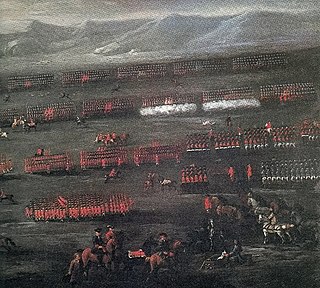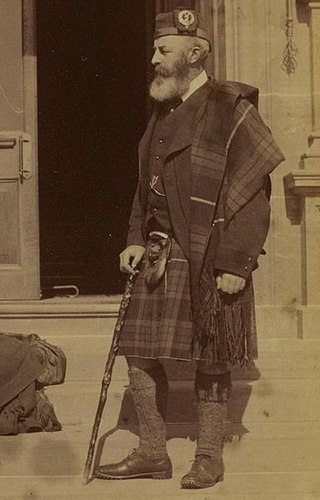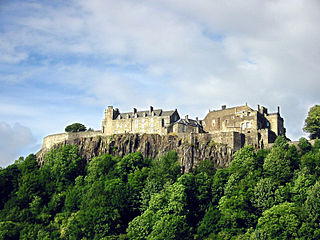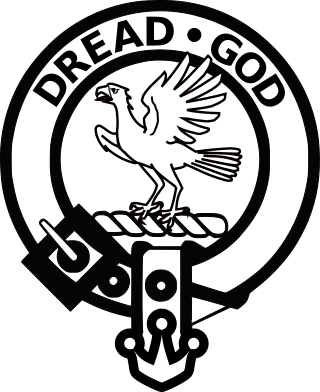See also
- Clan Stirling, a Scottish Lowlands clan, several of whom are named "Archibald"
Archibald Stirling may refer to:

Lieutenant-Colonel Sir Archibald David Stirling, was a Scottish officer in the British Army and the founder and creator of the Special Air Service (SAS). Under his leadership, the SAS carried out hit-and-run raids behind the Axis lines of the North African campaign. He saw active service during the Second World War until he was captured in January 1943. He spent the rest of the war in captivity, despite making several attempts to escape.

Clan Campbell is a Highland Scottish clan, historically one of the largest and most powerful of the Highland clans. The Clan Campbell lands are in Argyll and within their lands lies Ben Cruachan. The chief of the clan became Earl of Argyll and later Duke of Argyll.

David Leslie, 1st Lord Newark was a Scottish military officer and peer. During the Thirty Years' War, he joined in the Swedish Army in 1630 and served under Alexander Leslie. Returning to Scotland in the final days of the Bishops' War, Leslie fought in the English Civil War and Scottish Civil Wars on the side of the Covenanters and Royalists. After the Stuart Restoration, Leslie was raised to the peerage of Scotland as Lord Newark by Charles II of England.
Menzies is a Scottish surname, with Gaelic forms being Méinnearach and Méinn, and other variant forms being Menigees, Mennes, Mengzes, Menzeys, Mengies, and Minges.

The Battle of Sheriffmuir was an engagement in 1715 at the height of the Jacobite rising in England and Scotland. The battlefield has been included in the Inventory of Historic Battlefields in Scotland and protected by Historic Scotland under the Scottish Historical Environment Policy of 2009. Sheriffmuir is a remote elevated plateau of heathland lying between Stirling and Auchterarder on the north fringe of the Ochil Hills.
Colquhoun is a surname of Scottish origin. It is a habitational name from the barony of Colquhoun in Dunbartonshire. The Scottish Clan Colquhoun originated there. The name is possibly derived from the Gaelic elements còil ("nook"), cùil ("corner"), or coill(e) ("wood") + cumhann ("narrow"), or comh-thonn. The "l" is typically silent per developments in the Scots language.

Clan Fraser of Lovat is a Highland Scottish clan and the principal branch of Clan Fraser. The Frasers of Lovat are strongly associated with Inverness and the surrounding area since the Clan's founder gained lands there in the 13th century.

Clan Sutherland also known as House of Sutherland is a Highland Scottish clan whose traditional territory is the shire of Sutherland in the far north of Scotland. The chief of the clan was also the powerful Earl of Sutherland; however, in the early 16th century, this title passed through marriage to a younger son of the chief of Clan Gordon. The current chief is Alistair Sutherland, who holds the title Earl of Sutherland.

Clan Murray is a Highland Scottish clan. The chief of the Clan Murray holds the title of Duke of Atholl. Their ancestors were the Morays of Bothwell who established the family in Scotland in the 12th century. In the 16th century, descendants of the Morays of Bothwell, the Murrays of Tullibardine, secured the chiefship of the clan and were created Earls of Tullibardine in 1606. The first Earl of Tullibardine married the heiress to the Stewart earldom of Atholl and Atholl therefore became a Murray earldom in 1626. The Murray Earl of Atholl was created Marquess of Atholl in 1676 and in 1703 it became a dukedom. The marquess of Tullibardine title has continued as a subsidiary title, being bestowed on elder sons of the chief until they succeed him as Duke of Atholl.

Simon Fraser, 13th Lord Lovat and 2nd Baron Lovat, was a British nobleman, landowner, and soldier. He was the 22nd Chief of Clan Fraser of Lovat in the Scottish Highlands, and responsible for overseeing the reconstruction of Beaufort Castle.

The second Battle of Stirling was fought on 12 September 1648 during the Scottish Civil War of the 17th century. The battle was fought between the Engagers who were a faction of the Scottish Covenanters under the command of George Munro, 1st of Newmore and who had made "The Engagement" with Charles I of England in December 1647, against the Kirk Party who were a radical Presbyterian faction of the Scottish Covenanters who were under the command of Archibald Campbell, 1st Marquess of Argyll.

Clan Montgomery is a Scottish clan of the Scottish Lowlands.

Clan Stirling is a Scottish clan of the Scottish Lowlands.

Clan Rollo is a Lowland Scottish clan seated at Pitcairns House, Perthshire. The Chief of the Clan is styled Lord Rollo.
Archibald Hugh Stirling, Laird of Keir, is a Scottish theatrical producer, a former officer in the Scots Guards, and Laird of the Keir estate at Lecropt in the Stirling council area in Scotland.

The Whiggamore Raid was a march on Edinburgh by supporters of the Kirk faction of the Covenanters to take power from the Engagers whose army had recently been defeated by the English New Model Army at the Battle of Preston (1648).

Clan Munro is a Highland Scottish clan. Historically the clan was based in Easter Ross in the Scottish Highlands. Traditional origins of the clan give its founder as Donald Munro who came from the north of Ireland and settled in Scotland in the eleventh century, though its true founder may have lived much later. It is also a strong tradition that the Munro chiefs supported Robert the Bruce during the Wars of Scottish Independence. The first proven clan chief on record however is Robert de Munro who died in 1369; his father is mentioned but not named in a number of charters. The clan chiefs originally held land principally at Findon on the Black Isle but exchanged it in 1350 for Estirfowlys. Robert's son Hugh who died in 1425 was the first of the family to be styled "of Foulis", despite which clan genealogies describe him as 9th baron.

Lieutenant-General Sir James Campbell, 1st Baronet was a British Army officer, politician and colonial administrator. He was Governor and Commander-in-Chief of the Ionian Islands, Adjutant-General to the British Forces and Heritable Usher of the White Rod for Scotland. He is buried at Westminster Abbey.
Sir William Oliphant, was a Scottish knight and Governor of Stirling Castle during the Wars of Scottish Independence. He switched loyalties to the English and died in a Scottish prison.
Brigadier General Archibald Stirling, DL, of Keir and Cawdor was a Scottish officer of the British Army who also served as a Member of Parliament.